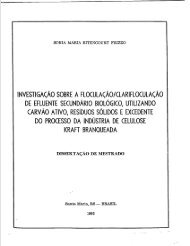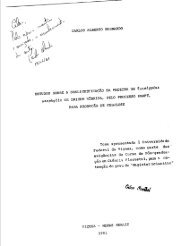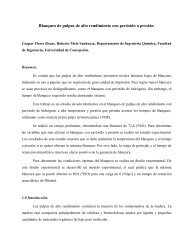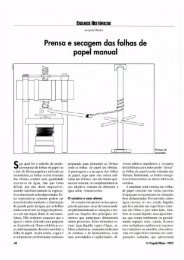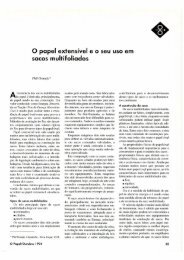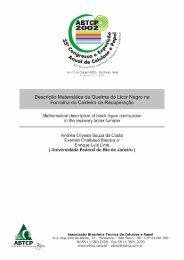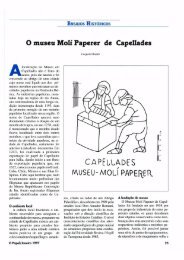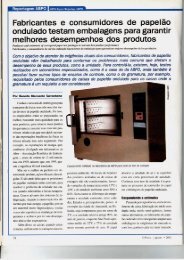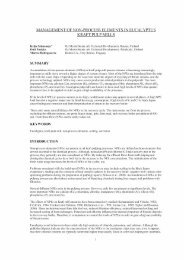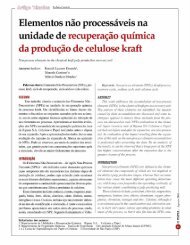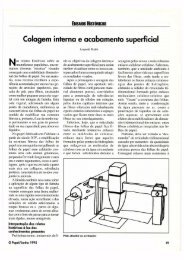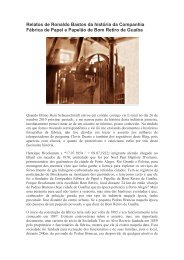O Eucalipto: um século no Brasil (The Eucalypt - Celso Foelkel
O Eucalipto: um século no Brasil (The Eucalypt - Celso Foelkel
O Eucalipto: um século no Brasil (The Eucalypt - Celso Foelkel
Create successful ePaper yourself
Turn your PDF publications into a flip-book with our unique Google optimized e-Paper software.
As indústrias que utilizam o eucalipto como matéria-prima distribuem não apenas mudas<br />
da árvore, como também de árvores nativas. Os fazendeiros são obrigados pela legislação<br />
ambiental a manterem a mata ciliar com árvores nativas em tor<strong>no</strong> dos mananciais. Como<br />
não têm facilidade para produzir mudas dessas árvores, fica mais fácil conseguí-las junto<br />
às grandes empresas, que as produzem em quantidade para recuperação das matas nativas<br />
lindeiras às florestas de eucalipto que plantam.<br />
Esse trabalho de fomento não é assistencialista, mas o foco é ensinar o agricultor a se<br />
beneficiar de <strong>um</strong>a <strong>no</strong>va cultura bastante rentável. Até mesmo comunidades indígenas<br />
localizadas <strong>no</strong> entor<strong>no</strong> das grandes produtoras de eucalipto associadas à ABRAF têm se<br />
beneficiado com os projetos de fomento. Há vários casos em que os acordos firmados permitem<br />
a utilização em comodato de áreas das empresas, com o que se consegue geração<br />
de renda e ocupação de mão-de-obra sem especialização.<br />
O incentivo à apicultura através de parcerias locais é outro tipo de projeto que agrega valor<br />
à produção rural e acaba envolvendo as famílias dos agricultores.<br />
O mais importante, porém, continua sendo o fomento florestal, <strong>um</strong>a das modalidades de<br />
produção mais adotadas <strong>no</strong> país, e que favorece a produção de matéria-prima, o desenvolvimento<br />
social e a defesa de interesses comuns, entre os quais é preciso destacar a<br />
conservação ambiental de extensas áreas e a busca da sustentabilidade.<br />
O E U C A L I P T O - U M S É C U L O N O B R A S I L<br />
88<br />
Industries that use eucalypt distribute <strong>no</strong>t only its seedlings, but native trees too. Farmers<br />
are required, by the environmental law, to maintain the cooperage and the native<br />
trees around the water sources. As he does <strong>no</strong>t have the facilities to produce seedlings, it<br />
is easier to get them from major corporations, which produce them in large n<strong>um</strong>bers to<br />
increase the size of the native forests that surround the eucalypt forests they plant.<br />
This fomentation work is by <strong>no</strong> means a handout policy, rather it focuses on teaching<br />
farmers to benefit from a new, rather profitable crop. Even Indian communities located<br />
around major eucalypt producers associated to the ABRAF have benefitted from the<br />
fomentation projects. In several cases, loan for use agreements were signed to allow<br />
these companies areas to be used. This allows income generation and unspecialized<br />
labor occupation.<br />
<strong>The</strong> incentive to apiculture, through partnerships with local farmers, is a<strong>no</strong>ther type of<br />
project that <strong>no</strong>w adds value to rural production and involves farmer families.<br />
<strong>The</strong> most important feature, however, is still forest fomentation, one of the production<br />
modes that has been adopted the most in Brazil and favors raw material production,<br />
social development, and the defense of common interests, among which the spotlight is<br />
on environmental protection for extensive areas and the quest for sustainability.




